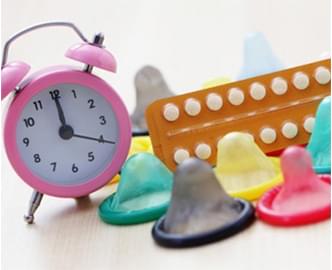
1. Pills and Mini Pills
-
General Features:
-
Must be taken daily.
-
Prevents ovulation and fertilization.
-
Very effective when used correctly.
-
Should be started within the first five days of menstruation, preferably on the first day.
-
Reduces premenstrual syndrome and menstrual cramps.
-
Protective against uterine and ovarian cancers.
-
Reduces menstrual bleeding, providing protective effects against anemia.
-
Does not protect against sexually transmitted infections (STIs) like HIV/AIDS, hepatitis B, syphilis, gonorrhea, and chlamydia.
-
-
Pills:
-
Contain two naturally occurring female hormones (estrogen and progesterone).
-
Women over 35 who smoke should quit smoking when using pills.
-
Not suitable for breastfeeding mothers as it reduces milk production and alters its composition.
-
-
Mini Pills:
-
Contain only one naturally occurring female hormone (progesterone).
-
Suitable for breastfeeding mothers as it does not affect milk production.
-
2. Monthly Injection
-
Administered monthly via injection into the muscle.
-
Contains two naturally occurring female hormones (estrogen and progesterone).
-
Prevents ovulation and fertilization.
-
Very effective when used correctly.
-
Should be administered within the first seven days of menstruation, preferably on the first day.
-
Suitable for women over 35 and those who smoke after quitting smoking.
-
Not suitable for breastfeeding mothers as it reduces milk production and alters its composition.
-
Does not protect against sexually transmitted infections.
3. Quarterly Injection
-
Administered every three months via injection into the muscle.
-
Contains only one naturally occurring female hormone (progesterone).
-
Prevents ovulation and fertilization.
-
Very effective when used correctly.
-
Should be administered within the first seven days of menstruation, preferably on the first day.
-
May cause spotting, and after long-term use, periods may stop entirely.
-
Suitable for breastfeeding mothers as it does not affect milk production.
-
Does not protect against sexually transmitted infections.
4. Subdermal Implants
-
Small silicone rods placed under the skin of the arm.
-
Contains only one naturally occurring female hormone (progesterone).
-
Prevents ovulation and fertilization.
-
Effective for three to five years depending on the type.
-
Very effective.
-
Can be administered on any day as long as the woman is not pregnant, ideally within the first seven days of menstruation.
-
May cause spotting or a reduction in menstrual bleeding.
-
Suitable for breastfeeding mothers as it does not affect milk production.
-
Does not protect against sexually transmitted infections.
5. Intrauterine Device (IUD)
-
A small plastic device inserted into the uterus.
-
Can be copper or hormone-based.
-
Prevents fertilization.
-
Very effective.
-
Copper IUDs can last up to 10 years.
-
Can be inserted at any time, and menstruation is not required for the procedure.
-
Can become pregnant immediately after removal.
-
May cause spotting, increased menstrual bleeding, or menstrual cramps initially.
-
Suitable for breastfeeding mothers as it does not affect milk production.
-
Does not protect against sexually transmitted infections.
-
Proper use will not lead to infection.
6. Condom (Male and Female)
-
A thin, flexible rubber sheath worn by the male during intercourse.
-
Prevents sperm from entering the woman's vagina.
-
Very effective when used correctly.
-
A new condom must be used for each sexual act. It should be put on before any genital contact, and removed after ejaculation.
-
Protects against sexually transmitted infections like HIV/AIDS, hepatitis B, syphilis, gonorrhea, and chlamydia.
-
No side effects.
7. Diaphragm
-
A soft, dome-shaped device that fits over the cervix.
-
Prevents sperm from entering the uterus.
-
Very effective when used correctly.
-
Should be inserted before intercourse and removed at least six hours afterward.
-
Can be used for up to two years if properly cleaned.
-
Suitable for breastfeeding mothers as it does not affect milk production.
-
Provides partial protection against some sexually transmitted infections.
8. Female Condom
-
A transparent, soft, plastic sheath inserted into the woman's vagina before intercourse.
-
Prevents sperm from entering the vagina.
-
Very effective with the use of spermicide.
-
A new female condom should be used for each sexual act.
-
Suitable for breastfeeding mothers as it does not affect milk production.
-
Protects against sexually transmitted infections (HIV/AIDS, hepatitis B, syphilis, gonorrhea, chlamydia).
-
No side effects.
9. Spermicides
-
Gels, suppositories, or foams inserted into the vagina.
-
Kills sperm, preventing fertilization.
-
Very effective when used correctly.
-
Must be reapplied before each act of intercourse.
-
Suitable for breastfeeding mothers as it does not affect milk production.
-
Provides partial protection against some sexually transmitted infections.
10. Female Sterilization (Tubal Ligation)
-
A surgical procedure where the fallopian tubes are cut or blocked.
-
Prevents eggs from meeting sperm.
-
Very effective.
-
Does not affect sexual desire or menstrual cycles.
-
Does not require hospitalization.
-
Does not protect against sexually transmitted infections.
11. Male Sterilization (Vasectomy)
-
A surgical procedure where the sperm ducts are cut or blocked.
-
Prevents sperm from mixing with semen during ejaculation.
-
Very effective.
-
Does not affect sexual desire or sexual performance.
-
A written consent from both partners is required.
-
Does not protect against sexually transmitted infections.
Family Planning Services in the United States
-
Family planning services are offered by various healthcare facilities, including hospitals, clinics, and family planning centers.
-
These services include counseling and all available contraceptive methods, as well as guidance on sexual and reproductive health.

